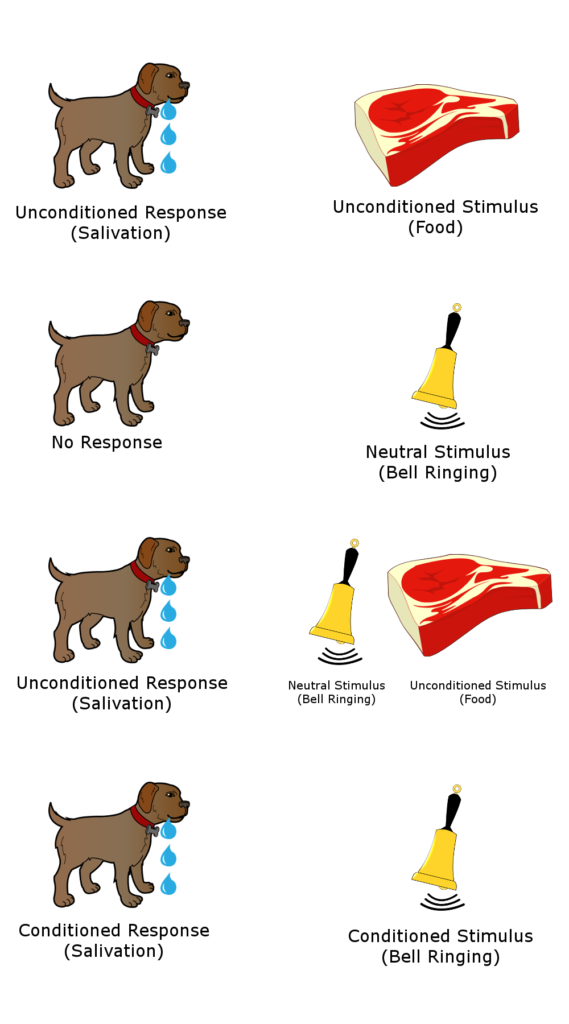Success often hinges on the ability to influence consumer behavior in businesses. “Conditioned stimulus” is one powerful tool that companies have been utilizing for decades. Through the pairing of stimuli with desired responses, businesses have learned to create strong associations that can drive sales, brand loyalty, and overall success.

The above picture can be well understood by article published here.
Or can be watched As below:
Understanding the Conditioned Stimulus
A conditioned stimulus, or CS, is a concept borrowed from psychology, specifically from classical conditioning theory. In the business world, it refers to a previously neutral stimulus that, through repeated association with a primary stimulus, comes to evoke a specific response from consumers.
The concept can further be understood by diving deep into classical and operant conditioning. The complete article can be read here.
Let’s dive into some real-time statistics and stories to see how this concept plays a pivotal role in the success of modern businesses.
Brand Logos: A Powerful Conditioned Stimulus
When you think about global brands like Apple or Coca-Cola, their logos probably come to mind almost instantly. That’s because these logos have become conditioned stimuli associated with the quality and experience their products provide. According to a recent survey, 93% of consumers around the world recognize the Apple logo, highlighting the powerful conditioning effect it has on consumer behavior.
E-commerce and Online Shopping
In the era of online shopping, conditioned stimuli are more critical than ever. Consider Amazon’s “1-Click Purchase” button. The orange “Buy Now” button on the platform has been meticulously designed and positioned to trigger immediate purchase decisions. As a result, Amazon reported a 15% increase in conversion rates after implementing this feature, showcasing the immense power of a conditioned stimulus.
Fast Food Industry
The fast-food industry has mastered the art of using conditioned stimuli to drive sales. McDonald’s iconic golden arches, for instance, are not just a logo but a symbol deeply ingrained in consumers’ minds. A recent study revealed that consumers exposed to the golden arches are 30% more likely to choose McDonald’s over other fast-food options.
Social Media Engagement
Social media platforms rely heavily on conditioned stimuli to keep users engaged. The red notification icon on Facebook, for instance, has become a conditioned stimulus for social interaction. An average Facebook user checks the platform 14 times a day, often driven by the anticipation of new notifications.
Subscription Services
Subscription-based businesses like Netflix and Spotify utilize conditioned stimuli in their user interface design. The “Next Episode” countdown on Netflix and the “Listen to a Playlist” suggestion on Spotify are prime examples. These features keep users engaged and encourage longer subscription periods, directly impacting business revenues.
Digital Advertising
In the realm of digital advertising, businesses use conditioned stimuli to increase click-through rates and conversions. For example, an online clothing retailer might show ads featuring models wearing their products, creating an association between attractive imagery and the brand. Over time, consumers become conditioned to click on such ads when they see them, leading to higher engagement and sales.
Email Marketing
Subject lines and email content can serve as conditioned stimuli. Consistently delivering valuable content or promotions in emails conditions recipients to open and engage with messages from a particular sender. The effectiveness of email marketing campaigns often relies on this conditioned response.
Customer Loyalty Programs
Loyalty programs are designed to create conditioned stimuli. For instance, a coffee shop’s loyalty card or app can feature a progress bar that fills up with each purchase. Customers become conditioned to seek that reward, encouraging repeat business and brand loyalty.
Product Packaging
The design and packaging of products can serve as conditioned stimuli. Think of the iconic shape and color of a Coca-Cola bottle or the golden arches of McDonald’s packaging. These visual cues not only attract customers but also signify quality and consistency.
Online Reviews and Testimonials
Positive online reviews and testimonials act as conditioned stimuli, building trust and credibility for businesses. When potential customers see glowing reviews, they are more likely to choose a product or service, creating a conditioned response to social proof.
Retail Store Layouts
In physical retail, the layout of the store can function as a conditioned stimulus. For example, placing essential or frequently purchased items at the back of the store encourages customers to walk through the entire store, potentially increasing impulse purchases.
Seasonal Marketing
Seasonal marketing campaigns, such as holiday-themed ads, capitalize on conditioned responses tied to specific times of the year. Consumers anticipate these campaigns, making them more receptive to related promotions and products.
Neuromarketing Techniques
Some businesses employ neuromarketing, using brain-scanning technologies to understand how consumers respond to various stimuli. This data informs marketing strategies, allowing companies to create more effective conditioned responses in their target audience.
Conclusion
The concept of conditioned stimulus is an integral part of business strategy. By skillfully crafting associations between stimuli and desired consumer responses, companies can drive brand loyalty, increase sales, and enhance the overall customer experience. As the business landscape continues to evolve, understanding and harnessing the power of conditioned stimuli will be a game-changer for those looking to succeed in the market.
In summary, whether it’s through iconic logos, user interface design, or online shopping features, the conditioned stimulus is a psychological tool that businesses leverage to influence consumer behavior, creating a win-win situation for both consumers and businesses.
